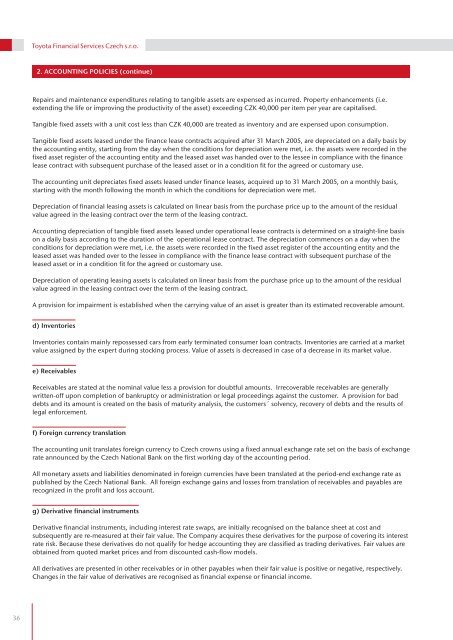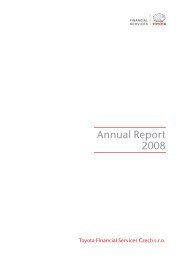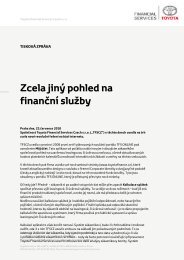Annual Report 2009 - Toyota Financial Services
Annual Report 2009 - Toyota Financial Services
Annual Report 2009 - Toyota Financial Services
Create successful ePaper yourself
Turn your PDF publications into a flip-book with our unique Google optimized e-Paper software.
<strong>Toyota</strong> <strong>Financial</strong> <strong>Services</strong> Czech s.r.o.2. ACCOUNTING POLICIES (continue)Repairs and maintenance expenditures relating to tangible assets are expensed as incurred. Property enhancements (i.e.extending the life or improving the productivity of the asset) exceeding CZK 40,000 per item per year are capitalised.Tangible fixed assets with a unit cost less than CZK 40,000 are treated as inventory and are expensed upon consumption.Tangible fixed assets leased under the finance lease contracts acquired after 31 March 2005, are depreciated on a daily basis bythe accounting entity, starting from the day when the conditions for depreciation were met, i.e. the assets were recorded in thefixed asset register of the accounting entity and the leased asset was handed over to the lessee in compliance with the financelease contract with subsequent purchase of the leased asset or in a condition fit for the agreed or customary use.The accounting unit depreciates fixed assets leased under finance leases, acquired up to 31 March 2005, on a monthly basis,starting with the month following the month in which the conditions for depreciation were met.Depreciation of financial leasing assets is calculated on linear basis from the purchase price up to the amount of the residualvalue agreed in the leasing contract over the term of the leasing contract.Accounting depreciation of tangible fixed assets leased under operational lease contracts is determined on a straight-line basison a daily basis according to the duration of the operational lease contract. The depreciation commences on a day when theconditions for depreciation were met, i.e. the assets were recorded in the fixed asset register of the accounting entity and theleased asset was handed over to the lessee in compliance with the finance lease contract with subsequent purchase of theleased asset or in a condition fit for the agreed or customary use.Depreciation of operating leasing assets is calculated on linear basis from the purchase price up to the amount of the residualvalue agreed in the leasing contract over the term of the leasing contract.A provision for impairment is established when the carrying value of an asset is greater than its estimated recoverable amount.d) InventoriesInventories contain mainly repossessed cars from early terminated consumer loan contracts. Inventories are carried at a marketvalue assigned by the expert during stocking process. Value of assets is decreased in case of a decrease in its market value.e) ReceivablesReceivables are stated at the nominal value less a provision for doubtful amounts. Irrecoverable receivables are generallywritten-off upon completion of bankruptcy or administration or legal proceedings against the customer. A provision for baddebts and its amount is created on the basis of maturity analysis, the customers´ solvency, recovery of debts and the results oflegal enforcement.f) Foreign currency translationThe accounting unit translates foreign currency to Czech crowns using a fixed annual exchange rate set on the basis of exchangerate announced by the Czech National Bank on the first working day of the accounting period.All monetary assets and liabilities denominated in foreign currencies have been translated at the period-end exchange rate aspublished by the Czech National Bank. All foreign exchange gains and losses from translation of receivables and payables arerecognized in the profit and loss account.g) Derivative financial instrumentsDerivative financial instruments, including interest rate swaps, are initially recognised on the balance sheet at cost andsubsequently are re-measured at their fair value. The Company acquires these derivatives for the purpose of covering its interestrate risk. Because these derivatives do not qualify for hedge accounting they are classified as trading derivatives. Fair values areobtained from quoted market prices and from discounted cash-flow models.All derivatives are presented in other receivables or in other payables when their fair value is positive or negative, respectively.Changes in the fair value of derivatives are recognised as financial expense or financial income.36











